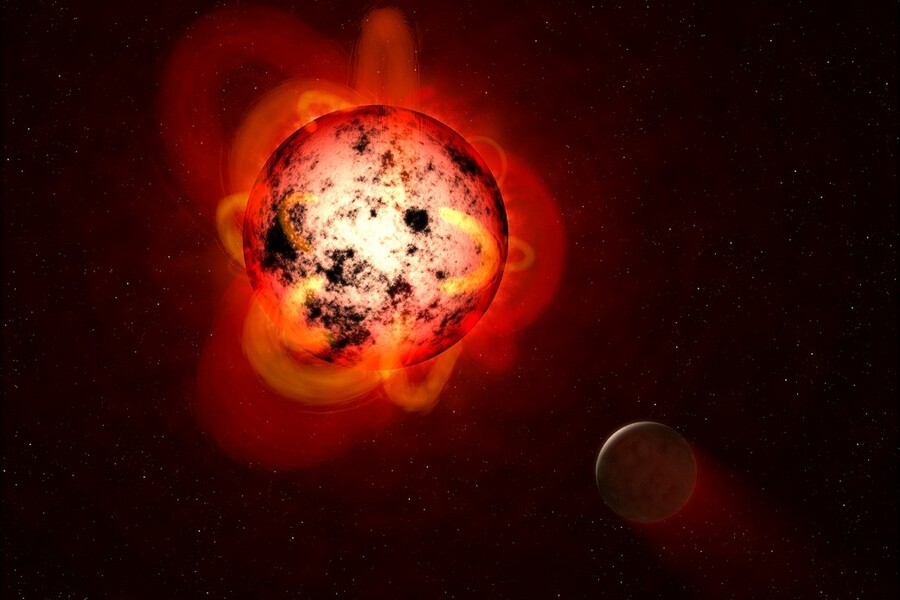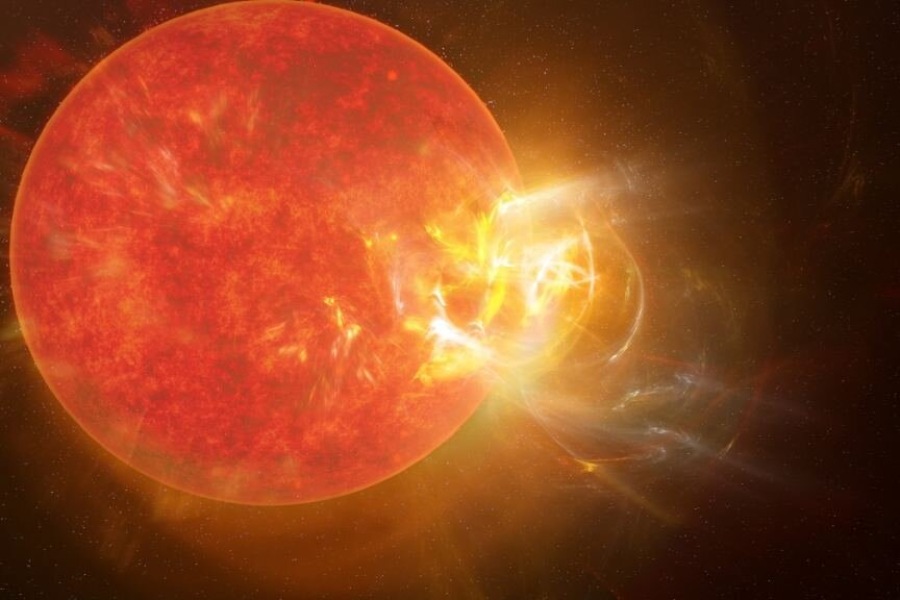Red dwarfs, the unsung heroes of the cosmos, play a pivotal role in our understanding of the universe, particularly in the context of exoplanetary systems. Despite their diminutive size, these stars wield significant influence, shaping the environments of orbiting planets and moons. But what are red dwarfs actually? How are red dwarfs formed?
Exploring red dwarfs is not merely an academic pursuit; it is essential for grasping the intricacies of planetary formation, evolution, and potential habitability. As we venture further into the depths of space, the importance of comprehending red dwarfs cannot be overstated.
Their prevalence in the galaxy suggests that many exoplanetary systems orbit around them, making them prime targets for studies related to astrobiology and the search for extraterrestrial life. So, read on to uncover the quirks and mysteries of these common yet cryptic stars known as red dwarfs.
What Are Red Dwarfs?
Red dwarfs are small, cool stars that shine red in the sky. They’re smaller and cooler than our Sun, making them the most common star type in the universe.
Despite appearing dimmer, some red dwarfs can live for trillions of years, far longer than our Sun. Scientists find them intriguing for potential alien life due to planets often orbiting in habitable zones, where life-friendly conditions might exist.

Location in the universe
Over 200 billion red dwarfs dwell in the Milky Way’s galactic disk, constituting 70% of its stars. Continuous red dwarf formation has thrived within the disk’s dense gas clouds for billions of years. But how long do red dwarfs live, and where do they reside?
The oldest red dwarfs, over 10 billion years old, reside in the galactic bulge, originating from the galaxy’s early stages. Remarkably, some can endure for trillions of years. Occasionally, gravitational interactions propel these ancient red dwarfs from the galactic disk to the sparsely populated halo, representing 0.1% of the stars.
Throughout their lifespans, hundreds of billions of red dwarfs traverse various regions of the galaxy. Despite this, the galactic disk remains the primary domain for these diminutive, cool stars, as interstellar gas continues generating new red dwarfs for countless trillions of years.
The Ubiquity and Significance of Red Dwarfs
There are likely over 200 billion red dwarfs in the Milky Way, comprising 60-70% of all stars in the galaxy. Recent surveys reveal these numerous faint stars are ubiquitous, even containing 20% of the total Milky Way stellar mass collectively. But the red dwarf star size being too small and their red glow makes them difficult to detect.
Complete counts of this predominant stellar population remain challenging. This leads to frequent increases in estimates for their numbers. New observations reveal more red dwarfs scattered across the galaxy. The closest known red dwarf to Earth is the faint Proxima Centauri, just over four light-years away in the Alpha Centauri system.
Continued mapping of red dwarfs is illuminating, as they trace out patterns of ordinary matter. This process helps us understand the structure and history of our galaxy. Our galaxy appears decisively dominated by these cool, small stars.
Nearest Known Red Dwarf to Earth
Proxima Centauri is just over four light-years from Earth, making it the nearest known red dwarf. With only 12% of the Sun’s mass, it emits a cool reddish glow, boasting a temperature of sub-3,000K. Despite its proximity, it’s challenging to spot without telescopic observation, as it has an apparent magnitude of 11.
Telescopic observation reveals a confirmed terrestrial exoplanet in Proxima Centauri’s habitable zone, potentially hosting liquid water given suitable atmospheric conditions. Yet, even closer, undiscovered red dwarfs likely exist nearby, their faintness posing detection challenges.
Proxima Centauri displays typical traits of magnetically active red dwarfs, such as frequent stellar flares surpassing the Sun’s strength. Additionally, it exhibits gradual brightness variations of a few percent over month-long spans, attributed to star spots rotating in and out of Earth’s view.
What Are Red Dwarfs: Structure and Composition
Red dwarfs consist mainly of hydrogen and helium gas, with traces of heavier elements. They have convective cores surrounded by radiative zones, lacking the clearly defined internal shell structure of more massive stars.
Despite their large size, red dwarf cores can sustain nuclear fusion for trillions of years. This is due to efficient convection. However, this fusion occurs at cooler temperatures, around 20 million Kelvin. This results in their reddish-hued luminosity.
Furthermore, red dwarfs have lower masses spread out over larger volumes, contrasting with stars like our Sun. Convection becomes the dominant mechanism for energy transport in a red dwarf’s interior instead of radiation.
So, they have the capacity to slowly burn their hydrogen fuel despite lower core temperatures. This enables them to have long lifespans as stable nuclear furnaces emitting a red glow.
Size of red dwarfs
Red dwarfs vary greatly in size. The smallest ones are just 0.08 solar masses and have a radius of 0.1 solar radii. On the other hand, the largest red dwarfs can reach up to 0.5 solar masses and have a radius of 0.6 solar radii.
Red dwarfs can readily host planetary systems. Their smaller masses enable red dwarf fusion to proceed slowly. This allows them to shine steadily for over a trillion years, ample time for complex life to evolve on planets orbiting these diminutive yet enduring stars.
Temperature of Red Dwarfs
Red dwarfs have relatively cool surface temperatures, ranging from less than 2,000 Kelvin up to about 4,000 Kelvin. The coolest red dwarfs diverge from hotter yellow dwarfs like our Sun, which has a temperature of 5,800 Kelvin.
Their cooler temperatures transmit emitted energy more in the infrared and redder wavelengths, giving red dwarfs their distinct reddish luminous appearance. However, this also causes greater variability than the Sun, with fluctuations of over 200 Kelvin.
Placing habitable zones 10 times closer, at just 0.1 astronomical units from the stellar surface. The redder spectra of red dwarfs deeply impact atmosphere dynamics on any potentially habitable worlds orbiting these extremely common yet dim and variable stars glowing red across the cosmos.

Conclusion
What are red dwarfs? They are a type of star characterized by their relatively small size and low mass. They are the most common type of star in the universe. Now that one knows, one can learn to spot red dwarfs in the night sky and appreciate how they dominate the stellar population of the Milky Way galaxy.
Red dwarfs, with their exceptional lifespan and ability to support planets, stand as promising prospects in the quest for extraterrestrial life. These stars offer distinct astrophysical conditions, with surface temperatures significantly cooler than our Sun, affecting any planets in their orbit. Despite this, red dwarfs showcase remarkable diversity in mass and size, contributing to their unique stellar classification.
